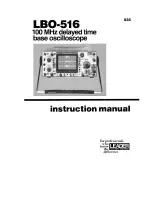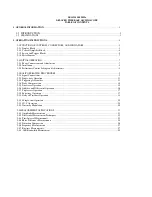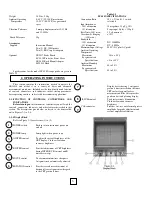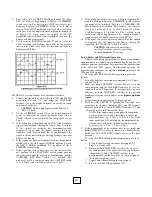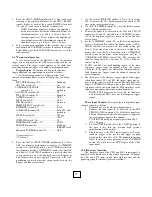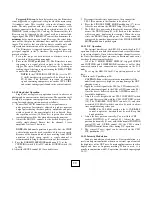
SOURCE switch To select the signal used for A or B
time-base triggering.
CH-1 position selects the channel 1
signal for triggering. CH-2 position
selects the channel 2 signal for
triggering.
ALT position selects the triggering
mode that allows a stable display of
two asynchronous signals on the CRT.
Must be used in conjunction with the
ALT vertical mode.
LINE position (A only) selects a trigger
signal derived from the AC power line,
permitting the scope to display
stabilized line-related components of a
signal even though they may be very
small compared to other signal
components.
0.2 V/DIV position selects the full
signal applied to the EXT TRIG IN
connector.
2 V/DIV position selects an attenuated
sample of the signal applied to the EXT
TRIG IN connector.
CH-3 or EXT TRIG For applying an external signal to the
IN connector oscilloscope for triggering the A
timebase and/or displaying the channel
3 trace.
COUPLING switch To select the frequency characteristics
of the coupling to the trigger circuits.
DC position selects direct trigger
coupling so all components of the
trigger signal are applied to the trigger
circuit.
AC position inserts a large capacitor in
the trigger-coupling chain to remove
any DC components from the trigger
signal. AC signals below 10 Hz are also
attenuated, as is the case in all of the
trigger coupling modes listed below.
HF-REJ position inserts a filter in the
trigger-coupling chain that removes
signal components higher in frequency
than 35 kHz.
TV-V (A only) position inserts a
shaping filter (TV sync separator)
whose low-frequency output (vertical
sync pulses) is used for triggering. This
trigger mode will also pass and
differentiate waveforms in the 1-100
Hz range.
TV-H position inserts a shaping filter
(TV sync separator) whose high-
frequency output (horizontal sync
pulses) is used for triggering. This
trigger mode will also pass and
differentiate waveforms in the 2-500
kHz range.
When triggered B sweep is selected as
the horizontal-display mode, and the
COUPLING switch is set to any
position other than TV-V, the A- and
B- time base trigger signals are
identical.
However,
when
the
COUPLING switch is set to TV-V
during triggered B sweep, the TV-V
shaping filter is inserted only in the A-
time base trigger signal. The trigger
signal fed to the B time base will be
shaped by the TV-H filter.
SWEEP MODE To select the triggering mode. AUTO
switches push-button allows sweep to flee-run
and display a base-line in the absence
of signal when pressed. Automatically
switches to triggered sweep mode when
signal of 20 Hz or higher is present and
other trigger controls are properly set.
NORM push-button produces sweep
only when signal is present and other
triggering controls are properly set. No
trace is visible if any trigger
requirement is missing.
SINGLE pushbutton disables recurrent
sweep operation when pressed. The
sweep generator can then be manually
reset before each sweep by depressing
this switch again. No trace is visible
before or after sweep occurs.
READY lamp Indicates when sweep generator is
armed for single-sweep operation.
Lamp is extinguished at start of sweep.
SLOPE switch Push-button selects the positive or
negative slope of the trigger signal for
initiating sweep. +position n causes
triggering on the positive-going edge or
slope of the trigger signal. - .position
causes triggering on the negative-going
edge or slope of the trigger signal.
LEVEL control Selects the amplitude level at which the
sweep is triggered. When rotated
clockwise (+ direction), the trigger
point moves towards the positive peak
of the trigger signal. When rotated
counterclockwise (- direction), the
trigger point moves towards the
negative peak of the trigger signal.
Pulling the HOLDOFF knob
(concentric to the LEVEL control)
selects PRESET level, a trigger point
near the zero-crossing point of the
trigger waveform.
34
36
37
35
36
38
39
40
6

